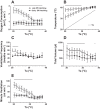Ventilation changes associated with hatching and maturation of an endothermic phenotype in the Pekin duck, Anas platyrhynchos domestica
- PMID: 26818053
- PMCID: PMC4867414
- DOI: 10.1152/ajpregu.00274.2015
Ventilation changes associated with hatching and maturation of an endothermic phenotype in the Pekin duck, Anas platyrhynchos domestica
Abstract
Precocial birds begin embryonic life with an ectothermic metabolic phenotype and rapidly develop an endothermic phenotype after hatching. Switching to a high-energy, endothermic phenotype requires high-functioning respiratory and cardiovascular systems to deliver sufficient environmental oxygen to the tissues. We measured tidal volume (VT), breathing frequency (ƒ), minute ventilation (V̇e), and whole-animal oxygen consumption (V̇o2) in response to gradual cooling from 37.5°C (externally pipped paranates, EP) or 35°C (hatchlings) to 20°C along with response to hypercapnia during developmental transition from an ectothermic, EP paranate to endothermic hatchling. To examine potential eggshell constraints on EP ventilation, we repeated these experiments in artificially hatched early and late EP paranates. Hatchlings and artificially hatched late EP paranates were able to increase V̇o2significantly in response to cooling. EP paranates had high ƒ that decreased with cooling, coupled with an unchanging low VT and did not respond to hypercapnia. Hatchlings had significantly lower ƒ and higher VT and V̇e that increased with cooling and hypercapnia. In response to artificial hatching, all ventilation values quickly reached those of hatchlings and responded to hypercapnia. The timing of artificial hatching influenced the temperature response, with only artificially hatched late EP animals, exhibiting the hatchling ventilation response to cooling. We suggest one potential constraint on ventilatory responses of EP paranates is the rigid eggshell, limiting air sac expansion during inhalation and constraining VT Upon natural or artificial hatching, the VT limitation is removed and the animal is able to increase VT, V̇e, and thus V̇o2, and exhibit an endothermic phenotype.
Keywords: endothermy; hypercapnia; minute ventilation; tidal volume; ventilation.
Copyright © 2016 the American Physiological Society.
Figures







Similar articles
-
Development of endothermy in birds: patterns and mechanisms.J Comp Physiol B. 2018 May;188(3):373-391. doi: 10.1007/s00360-017-1135-0. Epub 2017 Nov 8. J Comp Physiol B. 2018. PMID: 29119278 Review.
-
Manipulating plasma thyroid hormone levels at hatching alters development of endothermy and ventilation in Pekin duck (Anas platyrhynchos domestica).J Exp Biol. 2020 Nov 30;223(Pt 22):jeb237701. doi: 10.1242/jeb.237701. J Exp Biol. 2020. PMID: 33046566
-
Breathing while altricial: the ontogeny of ventilatory chemosensitivity in red-winged blackbird (Agelaius phoeniceus) nestlings.Am J Physiol Regul Integr Comp Physiol. 2016 Dec 1;311(6):R1105-R1112. doi: 10.1152/ajpregu.00273.2016. Epub 2016 Oct 5. Am J Physiol Regul Integr Comp Physiol. 2016. PMID: 27707721
-
Development of endothermy and concomitant increases in cardiac and skeletal muscle mitochondrial respiration in the precocial Pekin duck (Anas platyrhynchos domestica).J Exp Biol. 2016 Apr 15;219(Pt 8):1214-23. doi: 10.1242/jeb.132282. Epub 2016 Feb 19. J Exp Biol. 2016. PMID: 26896549
-
Metabolism, temperature, and ventilation.Compr Physiol. 2011 Oct;1(4):1679-709. doi: 10.1002/cphy.c100008. Compr Physiol. 2011. PMID: 23733685 Review.
Cited by
-
Post-hatching development of mitochondrial function, organ mass and metabolic rate in two ectotherms, the American alligator (Alligator mississippiensis) and the common snapping turtle (Chelydra serpentina).Biol Open. 2016 Apr 15;5(4):443-51. doi: 10.1242/bio.017160. Biol Open. 2016. PMID: 26962048 Free PMC article.
-
Manipulating plasma thyroid hormone levels alters development of endothermy and ventilation in nestling red-winged blackbirds.Front Physiol. 2022 Nov 29;13:1027257. doi: 10.3389/fphys.2022.1027257. eCollection 2022. Front Physiol. 2022. PMID: 36523554 Free PMC article.
-
Development of endothermy in birds: patterns and mechanisms.J Comp Physiol B. 2018 May;188(3):373-391. doi: 10.1007/s00360-017-1135-0. Epub 2017 Nov 8. J Comp Physiol B. 2018. PMID: 29119278 Review.
-
The 12-day thermoregulatory metamorphosis of Red-winged Blackbirds (Agelaius phoeniceus).J Comp Physiol B. 2016 Jul;186(5):651-63. doi: 10.1007/s00360-016-0978-0. Epub 2016 Mar 22. J Comp Physiol B. 2016. PMID: 27003423
References
-
- Azzam MA, Szdzuy K, Mortola JP. Hypoxic incubation blunts the development of thermogenesis in chicken embryos and hatchlings. Am J Physiol Regul Integr Comp Physiol 292: R2373–R2379, 2007. - PubMed
-
- Bech C, Johansen K, Brent R, Nicol S. Ventilatory and circulatory changes during cold exposure in the Pekin duck Anas platyrhynchos. Respir Physiol 57: 103–112, 1984. - PubMed
-
- Bennett AF, Ruben JA. Endotherm and activity in vertebrates. Science 206: 649–654, 1979. - PubMed
-
- Bucher TL, Bartholomew GA. The early ontogeny of ventilation and homeothermy in an altricial bird, Agapornis roseicollis (Psittaciformes). Respir Physiol 65: 197–212, 1986. - PubMed
-
- Dodd GAA, Scott GR, Milsom WK. Ventilatory roll off during sustained hypercapnia is gender specific in pekin ducks. Respir Physiol Neurobiol 156: 47–60, 2007. - PubMed
Publication types
MeSH terms
LinkOut - more resources
Full Text Sources
Other Literature Sources

